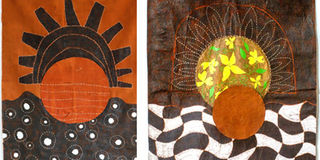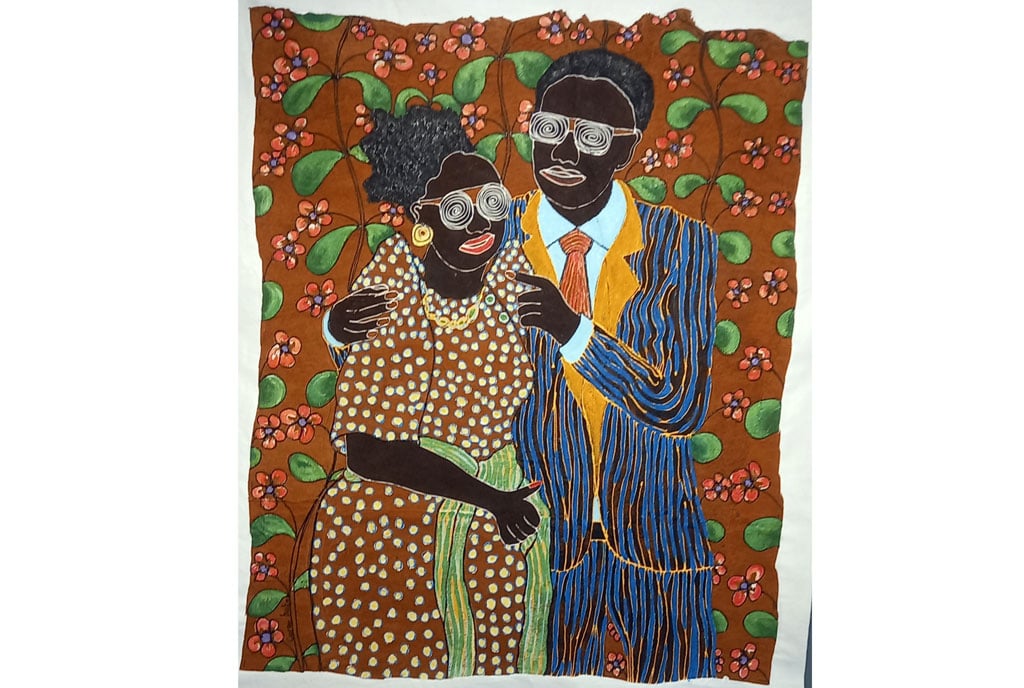Prime
Nyatho hails female food vendors in solo exhibition

Christine Nyatho’s Game Changer, which is on display in the Kafunda Mama exhibition at Amasaka Gallery in Masaka City. PHOTOS/BAMUTURAKI MUSINGUZI
What you need to know:
- On display at the show that closes on November 3, are Christine Nyatho’s 12 new beautiful large artworks made of embroidery and acrylics on barkcloth.
In her latest body of work, self-taught Ugandan artist Christine Nyatho pays tribute to female street food vendors in her first solo exhibition titled “Kafunda Mama.”
On display at the show that closes on November 3, are Nyatho’s 12 new beautiful large artworks made of embroidery and acrylics on barkcloth. The show opened on September 15 at the Amasaka Gallery in Masaka City in southern Uganda.
In the bustling melting pot of Kampala, where people from all corners of Uganda arrive to eke out a living, the kafunda mama holds everything together. Doubling as a bar and social place, her roadside shop (kafunda translates to “little place” in Luganda) sells alcohol and a great many things. Bufundas are informal businesses often operated by women as an accessible way to create an income.
Consequently, kafunda mama hustles for her family, waking up in the dead of night to prepare her business at a kafunda, cooking by the roadside, providing passersby with a hearty meal or school children with a bag of homemade crisps. Nyatho taps into this unstoppable life force of motherhood. She combines barkcloth and found fabrics, choosing to expose stitches added by the craftsman, as well as little scars originating from the process of the material’s production.

Christine Nyatho
Barkcloth is created by beating the bark of the wild fig tree (ficus natalensis) to flatten it out to a thin fabric. Wherever the cloth breaks in this process, the craftsman stitches it back together. Nyatho deliberately chooses parts of the barkcloth that are covered with these signs of tearing and healing. She then surrounds them with her own embroidery in the form of delicate, undulating lines of thread that are expanding between circular shapes and floral or avian imagery. This gives form to joyful goddesses, radiating growth in all their being without hiding their wounds.
In the circles composing her mothers’ silhouettes, the artist expresses her longstanding fascination with the moon and its remarkable effect on life on earth. The moon controls the seasons and tides and down to our every mood and state of being. Drawing silent circles around the earth, it keeps the planet on course and the cycles of life in movement.
Nyatho’s work is a declaration of love to the givers of love, thereby completing a cycle of its own. The artwork Blossom depicts yellow flowers and embroidery. It shows how a kafunda mama starts her day with a beautiful smile hoping to do better than yesterday.
Seasons shows two doves flying in the air and embroidery. Mama Gundi depicts the sun, moon and white dots. Drama Queen shows a star, moon and embroidery, signalling how kafunda mamas are always seeking attention in every corner of society.
Elsewhere, Game Changer depicts creeping plants, white and black patterns and embroidery. It speaks to the indefatigableness of kafunda mamas. Leafy Mind tells the story of a rural kafunda mama by showing the shape of a human head, necklace, green plants, and embroidery. Her Place captures the warm heart of a kafunda mama by showing food placed on a plate and embroidery.
“[Kafunda mamas] don’t just serve the society with eatables but also bring people together for the betterment of the society,” Nyatho says of the piece Togetherness, which is also food themed.
Her Craft shows patterns of different barkcloth, plants and embroidery. It tells the story of a kafunda mama, who makes handmade or woven mats, baskets and other handicrafts.
“This exhibition gave me the chance to tell a story that I have always wanted to tell about these women who make our lives easier through doing what they do in their small spaces (kafundas),” Nyatho says, adding: “Most of us believe a strong or successful woman is a lawyer, doctor, among others, but then we tend to forget that [kafunda mamas] contribute a lot to our societies.”

Christine Nyatho
On the connection between these woman’s food trade with motherhood, Nyatho, says: “If you take a good look at these women, about 90 percent of them are single mothers trying to put food on the table for their children […] they believe the easiest and fastest way to do that is by cooking or frying food on the roadside targeting all classes of life.”
Collin Sekajugo, the founder of Amasaka Gallery, says the gallery has so far sold four of Nyatho’s works from the show. Three of the works sold for $1,500 (Shs5.6m) and the bigger one, Mama Gundi, fetched $2,200 (Shs8.2m).
Who is Nyatho?
Born in 1993, Christine Nyatho is a mixed media artist working with locally found materials such as barkcloth, discarded paper and fabrics. She studied fine art in her O and A levels. She has been involved in different Weaver Bird Residency programmes, including the Art Camp, as well as the Make Masaka public art project. Her work was recently shown at Firetti Contemporary, Dubai in the United Arab Emirates.
Founded in 2020 by Sekajugo, Amasaka Gallery is dedicated to showcasing work by emerging artists and offering space for creative growth and experimentation




